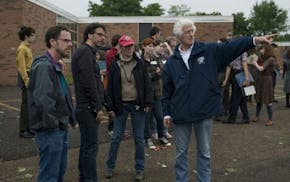There are 133 days left until the federally mandated switch to digital TV -- or, as I fondly think of it, 147 days until phone calls to me about it start tapering off. (I added a few weeks for the procrastinators.)
But seriously, the Minneapolis-St. Paul viewing area, which covers 51 counties in Minnesota and nine in Wisconsin, has the second-highest number of TV sets in the nation that are affected by the Feb. 17 transition. So it's no surprise that many of those affected -- people who watch TV on old analog sets using an over-the-air antenna -- have so many questions.
The easiest way for these people to keep watching TV would be to buy a digital set or subscribe to cable or satellite services, which are not affected by the switch. The cheapest thing to do would be to buy a converter box and keep the old set. The latter is what's causing problems.
Converter boxes connect between the TV and the antenna to convert over-the-air digital TV signals for viewing on older sets. The federal government is issuing $40 coupons to defray the cost of the converter boxes (see www.dtv2009.gov or call 1-888-388-2009 for details), meaning that the devices generally start at about $10 after the discount.
So far, 11.2 million people have redeemed the coupons for converter boxes, more than 310,000 of them in Minnesota, according to the National Telecommunications and Information Administration (NTIA). Based on reader feedback, complaints posted online and an early switchover to all-digital TV in Wilmington, N.C., some people are having troubles that have nothing to do with the box.
"One of the lessons we've learned from the Wilmington test is that the antennas are important," said Linda Yun, a spokeswoman for the National Association of Broadcasters (NAB) in Washington, D.C. "For people that have hooked up their boxes and are having trouble, it might not be the box. It might be that you need to get a stronger or better antenna or point it in a different direction. Things like the height of the antenna or the type can have an effect."
All Twin Cities TV stations broadcast digitally on UHF frequencies -- even those whose channel numbers still remain on the VHF band, such as WCCO-TV (Channel 4) and KARE-TV (Channel 11) -- so the UHF portion of your antenna is where you should focus your attention when adjusting it. Check Antenna Web (www.antennaweb.org) to find the best antenna for your address and advice on which direction to point it.
And don't forget: With a digital signal, the picture is either there or it isn't. There is no snow or fading in and out, which seems to confuse people who hook up a converter box and then don't see an image. Moving the antenna even slightly can drastically change your reception.
Here are other issues that have come up about the digital-TV transition:
Wider coupon availability: Starting Oct. 20, residents of nursing homes and those with post-office boxes will be able to apply for converter-box vouchers under a new definition of what constitutes a household. See the NTIA website (www.ntia.doc.gov) for details.
Better selection: Many people have wondered where they can find more than the one or two models of converter boxes that most stores carry. Online retailer Amazon.com carries 10 models, starting at $20 shipped after redeeming the coupon.
Video quality: Readers have asked which is the "best" converter box to buy. In some ways, that's like asking where to find the best extension cord, which I also consider fruitless. Converter boxes serve a basic function: converting digital TV signals to analog. Beyond that, the lower-priced models that everyone wants generally have comparable features and quality. To do better, you would have to buy the more expensive models, some of which don't qualify for the coupons. It's also unlikely that casual viewers are going to notice a huge difference on an old analog TV set anyway. Frankly, if you're concerned about picture quality, you should be shopping for a new TV with a digital tuner, not a converter box.
Radio reception: People with special portable radios that receive audio from TV stations will lose those feeds when the transition occurs. Depending on the device, it could be possible to rig a connection between the radio and a converter box, but that would defeat the purpose of having a portable radio because the boxes are bulky and need to be plugged in.
Misinformation: An alarming number of consumers report being told by store clerks and even their cable provider that they will lose cable reception on Feb. 17. Some unscrupulous cable representatives have even claimed as much while pitching higher-priced digital cable packages to confused customers. This is simply not true. Cable TV programming is not affected by the switchover.
"According to law, cable companies are required to continue broadcasting both analog and digital through 2012," Yun said. "People shouldn't have to upgrade to a digital package."
For more information about the transition to digital TV, check out the NAB's informational website DTV Answers (www.dtvanswers.com).
Randy A. Salas • 612-673-4542

This reporter didn't survive his audition for 'Survivor'
Spring's hot gift book features gorgeous found-nature photos

Jane Smiley hits again with 'Lucky' but what the what is that ending?

Biography details what 'Rulebreaker' Barbara Walters did to get to the top
